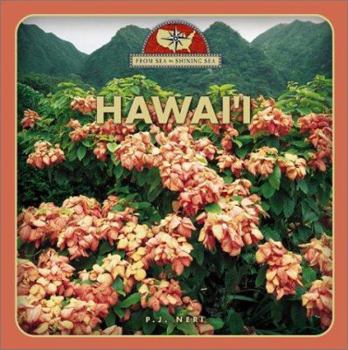Hawaii
Describes the geography, plants and animals, history, economy, language, culture and people of the state of Hawaii This description may be from another edition of this product.
Format:Library Binding
Language:English
ISBN:0516223836
ISBN13:9780516223834
Release Date:January 2003
Publisher:Children's Press(CT)
Length:80 Pages
Weight:1.06 lbs.
Dimensions:0.4" x 9.6" x 9.6"
Age Range:8 to 11 years
Grade Range:Grades 3 to 6
Customer Reviews
1 rating
Taking a tour of Hawai'i, the Aloha State
Published by Thriftbooks.com User , 18 years ago
Here we are at the end of the From Sea to Shining Sea, Second Series, and if there is one thing I have learned about the 50th state in the past year it is that the correct spelling is Hawai'i and not Hawaii (but apparently it is still Hawaiians and not Hawai'ians). Not that P.J. Neri explicitly points that out in Introducing the Aloha State, Chapter One of this informative and colorful book. She simply uses the correct spelling about a dozen times on those first two pages. Even if the correct spelling of Hawai'i is not familiar to young readers most of what Neri says come to mind when people think of the state will be: the bombing of Pearl Harbor, lava flows and fountains of fire, pineapples, hula dancing, and ukuleles. Neri builds on that common knowledge to teach young students about the geography, history, government, people and places of the 50th state. Chapter Two, The Land of Hawai'i, begins with the basic geological fact that the archipelago is not really a group of islands but really the tops of volcanic mountains. The other volumes in this series cover the different geographical regions of each state, but with Hawai'i that is not the case. Instead, Neri explains how each island has a nickname, an island color, and an official island flower or shell (e.g., O'ahu, "The Gathering Place," Yellow, "ilima"). She also covers how the tops of these volcanoes became lush green island paradises over time. However, it turns out there are several different climate regions in the islands (who would have expected a photograph of a snowboarder flying down the snow-covered slopes of Mauna Kea). Chapter Three, Hawai'i Through History, begins with Polynesian pioneers sailing their canoes 2,000 miles to these islands and becoming the first Hawaiian settlers. Neri explains the Hawaiian culture that developed before getting around to the arrival of the Europeans and the destruction of the islands' sandalwood forests, harvested to be sold to the Chinese, in just 25 years. A section is devoted to the reign of Kamehameha the Great, the chieftain who united all of the islands under his rule, and another to the end of the kapu system. Hawai'i was recognized as an independent kingdom in 1826 by the United States, and what proved to be the undoing of the kingdom was the Great Mahele (land division) of 1848 and the rise of the sugarcane plantations, which eventually lead to the annexationists (if Hawai'i was annexed, then planters would not have to pay taxes to sell its sugar in the U.S.). Hawai'i n the 20th century is the story of pineapple plantations, tourism, the attack on Pearl Harbor, and finally statehood in 1959. However, the final section looks at the economic problems the state has suffered in recent years because economic problems in Asia and September 11th have both significantly reduced tourism to the islands. Chapter Four, Governing Hawai'i begins with quick looks at the three branches of state government, and then Neri takes us on a




